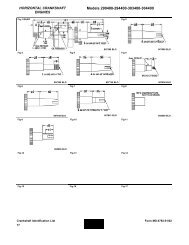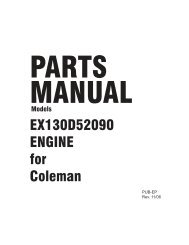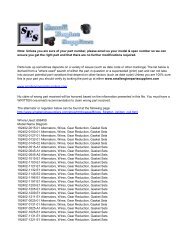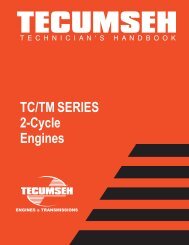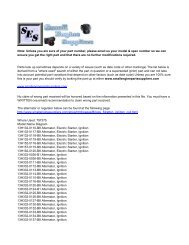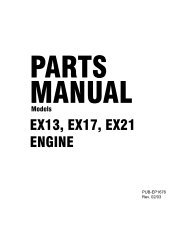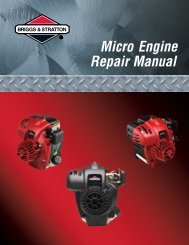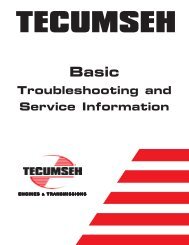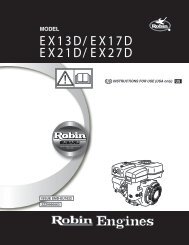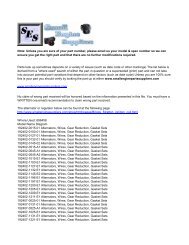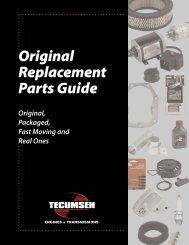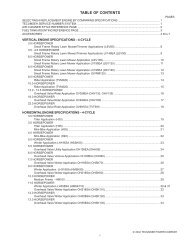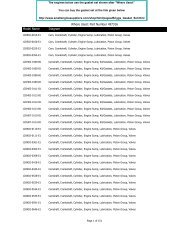2-Cycle Engines(TVS-TVXL 840) - Small Engine Suppliers
2-Cycle Engines(TVS-TVXL 840) - Small Engine Suppliers
2-Cycle Engines(TVS-TVXL 840) - Small Engine Suppliers
Create successful ePaper yourself
Turn your PDF publications into a flip-book with our unique Google optimized e-Paper software.
TECUMSEH<br />
T E C H N I C I A N ' S<br />
H A N D B O O K<br />
This manual covers the following models:<br />
<strong>TVS</strong>, <strong>TVXL</strong>, HXL, HSK <strong>840</strong> - 850<br />
Other illustrated Tecumseh 2-<strong>Cycle</strong> <strong>Engine</strong>, 4-<strong>Cycle</strong> <strong>Engine</strong><br />
and Transmission manuals; booklets; and wall charts are<br />
available through Tecumseh.<br />
For complete listing write or call<br />
HSK/HXL<strong>840</strong> - 850<br />
<strong>TVS</strong>/<strong>TVXL</strong><strong>840</strong><br />
2-<strong>Cycle</strong> <strong><strong>Engine</strong>s</strong>
TABLE OF CONTENTS<br />
Page<br />
ENGINE IDENTIFICATION AND CARE<br />
IDENTIFICATION ................................................................................................................................... 1<br />
INTERPRETATION OF MODEL NUMBER ............................................................................................ 1<br />
FUELS .................................................................................................................................................... 1<br />
ENGINE OIL ........................................................................................................................................... 1<br />
FUEL/OIL MIX ......................................................................................................................................... 1<br />
STORAGE .............................................................................................................................................. 2<br />
TUNE-UP PROCEDURE ........................................................................................................................ 2<br />
EXHAUST PORT CLEANING................................................................................................................. 2<br />
AIR CLEANER<br />
AIR CLEANER .................................................................................................................... .................... 3<br />
POLYURETHANE-TYPE AIR CLEANER ............................................................................................... 3<br />
PAPER TYPE AIR CLEANER ......................................................................................................... ....... 3<br />
KLEEN-AIRE ® CANISTER STYLE DUEL STAGE AIR CLEANER ......................................................... 3<br />
2 CYCLE THEORY OF OPERATION<br />
OPERATION OF HSK, HXL<strong>840</strong>-850 MODELS ...................................................................................... 4<br />
OPERATION OF <strong>TVS</strong>, <strong>TVXL</strong><strong>840</strong> ............................................................................................................ 4<br />
TERMS ................................................................................................................................................... 4<br />
EXHAUST OR SCAVENGE PHASE ...................................................................................................... 4<br />
PORTS .................................................................................................................................................... 4<br />
LUBRICATION ........................................................................................................................................ 4<br />
REED VALVE ......................................................................................................................................... 4<br />
CARBURETION<br />
CARBURETOR IDENTIFICATION ....................................................................................................... .. 5<br />
SERIES I OPERATION........................................................................................................................... 5<br />
SERIES VI OPERATION ........................................................................................................................ 5 - 6<br />
SERVICING THE CARBURETOR - SERIES VI<br />
REBUILDING THE CARBURETOR...................................................................................................... .. 7 - 8<br />
TROUBLESHOOTING CARBURETION SERIES VI<br />
TABLE OF PROBLEMS AND CORRECTIONS ..................................................................................... 9<br />
SERVICING THE CARBURETOR - SERIES I<br />
SERVICE ........................................................................................................................ ........................ 10<br />
SERVICE CARBURETOR PRE-SETS AND ADJUSTMENTS<br />
PRE-SETS AND ADJUSTMENTS ....................................................................................................... ... 11<br />
FINAL ADJUSTMENTS .......................................................................................................................... 11<br />
TROUBLESHOOTING CARBURETION SERIES I<br />
TABLE OF PROBLEMS AND CORRECTIONS ..................................................................................... 12<br />
PISTON AND RINGS<br />
<strong>840</strong> - 850 MODELS............................................................................................................... .................. 13<br />
E.G.R. TUBE - SERVICE AND INSTALLATION (<strong>TVS</strong>/<strong>TVXL</strong> <strong>840</strong> ONLY)<br />
PORT PLUG REINSTALLATION....................................................................................................... ..... 14<br />
ANTI-PUDDLING METER HOLE SCREEN<br />
REPLACEMENT OF SCREEN ............................................................................................................... 15<br />
SELF-ENERGIZING BRAKE SYSTEM<br />
DISASSEMBLY OF THE BRAKE SYSTEM ........................................................................................... 16<br />
REASSEMBLY OF THE BRAKE SYSTEM ............................................................................................ 16 - 17<br />
GOVERNOR LINKAGE AND ADJUSTMENT<br />
LINKAGE LOCATION ............................................................................................................................. 18<br />
GOVERNOR ADJUSTMENT .................................................................................................................. 18<br />
GOVERNOR FOLLOWER ARM AND SHAFT ASSEMBLY ................................................................... 18<br />
GOVERNOR LINKAGE AND ADJUSTMENT - HXL/HSK<strong>840</strong> - 850<br />
CONTROLS ............................................................................................................................................ 19<br />
REWIND STARTER<br />
TYPE I ..................................................................................................................................................... 20<br />
TYPE II .................................................................................................................................................... 20<br />
<strong>840</strong> - 850 DISASSEMBLY<br />
MODEL <strong>840</strong>-850 DISASSEMBLY ...................................................................................................... .... 21<br />
EXHAUST PORT CLEANING................................................................................................................. 22 - 25<br />
<strong>TVS</strong> & <strong>TVXL</strong> <strong>840</strong> REASSEMBLY<br />
<strong>840</strong> HORIZONTAL AND VERTICAL REASSEMBLY ............................................................................. 26 - 30<br />
TORQUE SPECIFICATIONS<br />
TORQUE LIMITS FOR REASSEMBLY .................................................................................................. 31<br />
ENGINE SPECIFICATIONS<br />
TOLERANCES IN THE ENGINES...................................................................................................... .... 32<br />
TRAINING AIDS AND TOOLS<br />
LISTING OF SPECIAL TRAINING AIDS AND TOOLS .......................................................................... 33 - 34<br />
C Tecumseh Products Company<br />
1996
ENGINE IDENTIFICATION AND CARE<br />
IDENTIFICATION<br />
Tecumseh engine Models <strong>840</strong> - 850, specification, and<br />
serial number or date of manufacture (D.O.M.) are<br />
stamped into the blower housing, or located on a decal<br />
on the engine in locations as shown.<br />
<strong>TVS</strong>/<strong>TVXL</strong> ENGINE<br />
IDENTIFICATION<br />
Interpretation of Model Number<br />
The letter designations in a model number indicate the<br />
basic type of engine. This is followed by the specification<br />
number and date of manufacture.<br />
HXL - Horizontal Extra Life<br />
HSK - Horizontal Snow King ®<br />
<strong>TVS</strong> - Tecumseh Vertical Style<br />
<strong>840</strong>/850 - Base engine model<br />
SPECIFICATION NUMBER<br />
Specification number used to locate correct parts.<br />
5215C<br />
is the serial number or D.O.M. (Date of<br />
Manufacture)<br />
5 is the last digit in the year of manufacture<br />
(1995).<br />
215 indicates the calendar day of that year<br />
(215th day or August 3, 1995).<br />
C<br />
HXL/HSK ENGINE<br />
IDENTIFICATION<br />
represents the line and shift on which the<br />
engine was built at the factory.<br />
FUELS. Tecumseh Products Company strongly<br />
recommends the use of fresh, clean, UNLEADED<br />
regular gasoline in all Tecumseh <strong><strong>Engine</strong>s</strong>. Unleaded<br />
gasoline burns cleaner, extends engine life and<br />
promotes good starting by reducing the build up of<br />
carbon deposits. Premium gas or gasohol containing<br />
no more than 10% ethanol can be used if unleaded fuel<br />
is not available.<br />
NOTE: NEVER USE GASOLINE CONTAINING<br />
METHANOL, GASOHOL CONTAINING MORE THAN<br />
10% ETHANOL, UNLEADED REGULAR GASOLINE<br />
CONTAINING MORE THAN 15% M.T.B.E. OR ETBE,<br />
GASOLINE ADDITIVES, OR WHITE GAS BECAUSE<br />
ENGINE/FUEL SYSTEM DAMAGE COULD RESULT.<br />
NOTE: In countries where unleaded gasoline is not<br />
available, regular gas can be used.<br />
Make sure that gasoline and oil are stored in clean,<br />
covered, rust free containers. Dirt in fuel can clog small<br />
ports and passages in the carburetor. Use fresh gasoline<br />
only. Gasoline standing for long periods of time develop<br />
a gum that will result in fouled spark plugs, clogged fuel<br />
lines, carburetors and fuel screens. Using fuel that is<br />
not fresh will cause engines to be hard starting,<br />
especially in cold temperatures.<br />
Clean gas cap, tank and fuel container spout when filling<br />
fuel tank, to assure that dirt will not get into fuel system.<br />
If gasohol is used, special care is required when the<br />
engine is to be stored for extended periods.<br />
ENGINE OIL. Use Clean, high quality 2 CYCLE OIL.<br />
NMMA TC-WII, or TC-W3.<br />
FUEL/OIL MIX. Follow fuel and engine oil requirements<br />
listed in the Owner’s Manual. Disregard conflicting<br />
instructions found on oil containers. The fuel/oil mix for<br />
all <strong>840</strong>-850’s is 50:1.<br />
NOTE: Sears Craftsman models use a 40:1 mix which<br />
is acceptable.<br />
NOTE: ALWAYS DOUBLE THE AMOUNT OF OIL<br />
FOR THE FIRST GALLON OF MIX FOR ENGINE<br />
BREAK IN.<br />
To assure thorough mixing of oil and gasoline, fill<br />
container with gasoline to one quarter full, add oil as<br />
recommended, shake container vigorously and then add<br />
remainder of gasoline. Do not mix directly in engine<br />
or equipment fuel tank.<br />
Some models will have a Mix-Rite cup attached to the<br />
under side of the air cleaner cover to assure proper fuel/<br />
oil mixture.<br />
The mixing chart below should be used for proper fuel<br />
and oil mix ratio.<br />
FUEL MIX CHART Mixture 50:1<br />
U.S.<br />
S.I. (METRIC)<br />
Gas Oil To Be Added Petrol Oil To Be Added<br />
1 Gal. 2-1/2 oz. 4 Liters 80 ml<br />
2 Gal. 5 oz. 8 Liters 160 ml<br />
5 Gal. 13 oz. 20 Liters 400 ml<br />
NOTE: Beginning with the 1998 Snowblower season,<br />
Horizontal Snow King ® engines will have Emission<br />
Compliance information on the identification decal.<br />
FUEL: REGULAR UNLEADED<br />
FUEL/OIL MIX 50:1<br />
<strong>TVXL</strong><strong>840</strong> <strong>840</strong>5F<br />
(E)<br />
5018B<br />
1
STORAGE:<br />
NEVER STORE ENGINE WITH FUEL IN TANK<br />
INDOORS OR IN ENCLOSED, POORLY<br />
VENTILATED ENCLOSURES WHERE FUEL<br />
FUMES MAY REACH AN OPEN FLAME, SPARK<br />
OR PILOT LIGHT AS ON A FURNACE, WATER<br />
HEATER, CLOTHES DRYER, ETC.<br />
If engine is to be stored over 30 days, prepare for storage<br />
as follows:<br />
1. Remove all gasoline from fuel tank to prevent gum<br />
deposits from forming in tank and other fuel system<br />
components, causing possible malfunction of the<br />
engine.<br />
DRAIN FUEL INTO APPROVED CONTAINER<br />
OUTDOORS, AWAY FROM OPEN FLAMES.<br />
Run engine until fuel tank is empty and engine stops<br />
due to lack of fuel.<br />
Fuel stabilizer (such as STA-BIL) is an acceptable<br />
alternative in minimizing the formation of fuel gum<br />
deposits during storage. Add stabilizer to fuel in fuel<br />
tank or storage container. Always follow mix ratio<br />
found on stabilizer container. Run engine at least<br />
10 minutes after adding stabilizer to allow it to reach<br />
carburetor.<br />
If gasohol has been used, complete preceding<br />
instructions and then add a small amount, one pint<br />
or less, of unleaded regular automotive gasoline<br />
properly mixed with the specified lubricating oil and<br />
run the engine until the fuel tank is empty and the<br />
engine stops due to lack of fuel.<br />
2. Pull starter handle slowly until resistance is felt due<br />
to compression pressure, then stop. Release starter<br />
tension slowly to prevent engine from reversing due<br />
to compression pressure. This position will close<br />
both the intake and exhaust ports to prevent<br />
corrosion of the piston and the cylinder bore.<br />
3. Clean unit by removing any dirt from exterior of the<br />
engine and equipment.<br />
TUNE-UP PROCEDURE. The following is a minor tuneup<br />
procedure. Repair procedures for this engine and<br />
it’s components are listed in this manual if the engine<br />
does not perform to satisfaction after tune-up is<br />
performed.<br />
CAUTION: Remove spark plug wire before doing<br />
any service work on engine.<br />
1. Service or replace air cleaner as necessary.<br />
NOTE: Snow King ® engines do not use an air filter<br />
due to the clean operating environment and to<br />
prevent filter freeze-up.<br />
2. Remove blower housing, clean all dirt, grass or<br />
debris from air intake screen, cylinder cooling fins,<br />
and carburetor governor levers and linkage.<br />
3. Remove carburetor, clean and install a carburetor<br />
kit, make adjustment presets where needed. Presets<br />
are found in the carburetor section of this manual.<br />
Make sure fuel tank, fuel filters and fuel lines are<br />
clean. Reinstall carburetor, replacing any worn or<br />
damaged governor springs or linkage. Make proper<br />
governor adjustment. Adjustments are found in the<br />
manual under governor linkage and adjustment and<br />
engine reassembly.<br />
4. Replace with correct spark plug.<br />
5. Make sure all ignition wires are properly routed, so<br />
they will not rub on flywheel. Inspect all ignition wires<br />
for abrasion or damage. Remove flywheel and<br />
check flywheel key, reinstall flywheel, torque<br />
flywheel nut to specifications. Set air gap between<br />
solid state module and flywheel at .0125'’. Air gap<br />
gauge, part no. 670297 may be used.<br />
6. The engine must be firmly mounted to the associated<br />
equipment. On rotary lawnmowers, make sure blade<br />
is properly balanced and correctly torqued. See<br />
dissassembly section for flywheel removal and air<br />
gap setting procedure.<br />
7. Make sure all remote linkage is properly adjusted<br />
for proper operation.<br />
8. Fill tank with proper fuel/oil mix.<br />
9. Run the engine, allow it to warm up 5 minutes, then<br />
adjust carburetor and set R.P.M. according to<br />
Tecumseh’s recommendations.<br />
Snow King ® engines should be run in outdoor<br />
temperatures for engine adjustments.<br />
COMPRESSION<br />
RELEASE HOLE<br />
EXHAUST PORT CLEANING. The exhaust ports<br />
should be cleaned after each seventy-five (75) to one<br />
hundred (100) hours of use.<br />
Before cleaning the ports place the piston in the Bottom<br />
Dead Center position. Then clean the ports using a<br />
pointed 3/8'’ diameter wooden dowel or similar tool. Be<br />
sure not to scratch the port area. Also remember to<br />
remove all the loose carbon particles from the engine.<br />
2
AIR CLEANER<br />
AIR CLEANER. Service the air cleaner frequently to<br />
prevent clogging of the element & screen and to prevent<br />
dust and dirt from entering the engine. Dust by- passing<br />
an improper or damaged air filter can quickly damage<br />
an engine. Always make certain covers and air cleaner<br />
connections are tightly sealed to prevent entry of dirt.<br />
NOTE: SNOW KING MODELS DO NOT HAVE AIR<br />
FILTERS DUE TO THE CLEAN ENVIRONMENT THEY<br />
OPERATE IN AND TO PREVENT AIR CLEANER<br />
FREEZE UP.<br />
If a loss of power occurs, inspect the air filter for clogging<br />
before making any adjustments.<br />
NOTE: Use factory recommended parts only.<br />
NOTE: Polyurethane type filters will lose effectiveness<br />
if stored for extended periods of time, due to oil migration<br />
out of the filter. Re-oil filter as necessary.<br />
PAPER TYPE AIR CLEANER. The paper type air<br />
cleaners found on some HXL, <strong>TVS</strong> and <strong>TVXL</strong><strong>840</strong>-850's<br />
should be replaced once a year or more often in<br />
extremely dirty or dusty conditions.<br />
DO NOT ATTEMPT TO CLEAN OR OIL PAPER<br />
FILTER'S.<br />
NEVER RUN THE ENGINE WITHOUT THE<br />
COMPLETE AIR CLEANER INSTALLED ON THE<br />
ENGINE IF SO EQUIPPED.<br />
COVER<br />
WING NUT<br />
FLOCKED SCREEN<br />
SCREEN<br />
(OPTIONAL - <strong>TVS</strong> ONLY)<br />
MIX RITE CUP<br />
POSITION<br />
(If equipped)<br />
POLYURETHANE<br />
ELEMENT<br />
PAPER ELEMENT<br />
(<strong>TVXL</strong> ONLY)<br />
AIR CLEANER<br />
BODY<br />
COVER<br />
EARLY<br />
PRODUCTION<br />
NUT WITH SEAL<br />
(SEE NOTE*)<br />
FOAM<br />
ELEMENT<br />
PAPER<br />
ELEMENT<br />
POLYURETHANE-TYPE AIR CLEANER. This<br />
serviceable air cleaner utilizes a polyurethane element<br />
which will clog with use. The element should be cleaned<br />
and serviced in the following manner.<br />
Wash element in a detergent and water solution and<br />
squeeze (don’t twist) until all dirt is removed. Rinse<br />
thoroughly.<br />
Wrap in clean cloth and squeeze (don’t twist) until<br />
completely dry.<br />
Clean air cleaner body and cover. Dry thoroughly.<br />
Re-oil element by applying generous quantity of engine<br />
oil to all sides. Squeeze vigorously to distribute oil and<br />
to remove excess oil.<br />
When reassembling polyurethane type air cleaners,<br />
replace in the same order as pictured above.<br />
Flocked screen elements may be cleaned by blowing<br />
compressed air through the screen from the back side.<br />
If screen can not be cleaned with this procedure, it<br />
should be replaced with a new screen.<br />
KLEEN-AIRE ® CANISTER STYLE DUAL STAGE AIR<br />
CLEANER. This air cleaner consists of a paper type<br />
element with a polyurethane pre-cleaner around it. For<br />
servicing the assembly see instructions under Paper<br />
Type Air Cleaner and Polyurethane Type Air Cleaner.<br />
Be sure to clean base and cover thoroughly before<br />
installing new paper filter.<br />
NOTE: When installing a new foam pre-cleaner always<br />
turn it inside out before installing around the paper<br />
element to prevent gaps between paper element and<br />
pre-cleaner.<br />
*NOTE*: Tecumseh has changed the cannister filter<br />
cartridge to remove the nut/seal assembly. If you receive<br />
a new filter with a rubber seal that is tight around the<br />
stud, follow the instruction sheet included regarding NOT<br />
RE-USING THE NUT.<br />
3
2 CYCLE THEORY OF OPERATION<br />
1.<br />
3.<br />
OPERATION OF HSK, HXL<strong>840</strong>-850 MODELS.<br />
2.<br />
4.<br />
A low pressure area is created in the crankcase as the<br />
piston moves upward to compress the air / fuel mixture<br />
in the cylinder. Then the piston moves far enough to<br />
uncover the intake port, the air / fuel mixture from the<br />
carburetor flows into the engine crankcase due to higher<br />
pressure atmospheric air. Just before the piston reaches<br />
top dead center (TDC), the spark plug ignites the<br />
air / fuel mixture in the cylinder.<br />
The expanding combustion gases force the piston down.<br />
The downward piston travel causes a pressure buildup<br />
in the crankcase. The piston uncovers the exhaust port<br />
first followed by the transfer ports. The exhaust flows<br />
out the exhaust port while the pressurized air / fuel<br />
mixture enters the cylinder from the crankcase through<br />
the transfer ports. As the piston travels upward the<br />
sequence is repeated.<br />
As the mixture flows into the combustion chamber<br />
through the transfer ports, it collides and is directed to<br />
the top of the combustion chamber looping when it<br />
strikes the cylinder head, thus forcing all spent gases<br />
out through the open exhaust ports.<br />
TERMS. Listed are common terms often referred to on<br />
2-cycle engines.<br />
EXHAUST or SCAVENGE PHASE. The burned gases<br />
must be cleared out of the combustion chamber and<br />
replaced by a fresh charge of fuel-air mixture through<br />
the intake ports. The exhaust passes out through the<br />
exhaust ports into the outside air.<br />
PORTS. Openings in the cylinder allow gases to pass<br />
into and out of the combustion chamber. The ports are<br />
opened or closed by the upward and downward<br />
movement of the piston.<br />
EXHAUST PORTS. Allow the burned gases to pass out<br />
of the combustion chamber.<br />
THIRD PORT (Sometimes called piston port). A third<br />
port is for entry of the fuel-air and oil mixture to the<br />
crankcase. From the crankcase the fuel-air mixture<br />
enters the combustion chamber through the intake ports.<br />
The third port is controlled by the piston skirt.<br />
LUBRICATION. Tecumseh 2-cycle engines are<br />
lubricated by a gas oil mix. The correct mix ratio of oil<br />
and gas combines with air in the venturi and enters the<br />
crankcase. During engine operation the oil clings to all<br />
the internal moving parts for lubrication.<br />
NOTE: ALWAYS MIX AT OUR RECOMMENDED<br />
RATIO AND USE ONLY CERTIFIED OILS OR<br />
WARRANTY IS VOID.<br />
REED VALVE. A reed valve is activated by crankcase<br />
pressure or vacuum. A decrease in crankcase pressure<br />
opens the valve allowing the fuel air and oil mixture to<br />
enter the crankcase. Increased crankcase pressure<br />
closes the valve, preventing escape of the fuel-air and<br />
oil mixture back through the carburetor.<br />
OPERATION OF <strong>TVS</strong>, <strong>TVXL</strong><strong>840</strong><br />
This model uses a loop scavenge system with a reed<br />
valve.<br />
The following illustrates the loop scavenge design which<br />
uses a vacuum-pressure activated reed valve. Here the<br />
ports are located on three sides of the cylinder; the intake<br />
ports are on two sides opposite each other, and the<br />
exhaust ports are illustrated by the three holes just above<br />
the head of the piston.<br />
4
CARBURETION<br />
CARBURETOR IDENTIFICATION<br />
Tecumseh carburetors are identified by a model number<br />
and code date stamped on the carburetor as illustrated.<br />
ALTERNATE LOCATION FOR<br />
MANUFACTURING NUMBER<br />
THROTTLE<br />
SHUTTER<br />
IDLE AIR<br />
BLEED<br />
MAIN AIR<br />
BLEED<br />
CHOKE<br />
SHUTTER<br />
IDLE<br />
ADJUSTMENT<br />
INLET NEEDLE<br />
AND SEAT<br />
FLOAT<br />
MAIN NOZZLE<br />
MAIN ADJUSTMENT<br />
NOTE: EITHER JET MAY BE FIXED TYPE. (NON- ADJUSTABLE)<br />
MANUFACTURING<br />
NUMBER<br />
CARBURETOR<br />
DATE CODE<br />
When servicing carburetors the model and date code<br />
number of the carburetor will be found on the carburetor<br />
body. It is a recommended procedure to use the engine<br />
model and specification number for looking up repair<br />
parts. However, if they are not available, the carburetor<br />
model number may be used for the proper carburetor<br />
repair parts. Cross reference the carburetor model<br />
number into a service part number using the Master<br />
Parts Manual or Microfiche and look up the required<br />
parts.<br />
SERIES I OPERATION. The HSK and HXL<strong>840</strong>-850<br />
models use a Series ( I ) carburetor. (Fixed speed<br />
models have no idle circuit with a fixed main jet.)<br />
Variable speed engines use a full circuit Series I which<br />
has an idle fuel circuit (as shown above).<br />
VENTED<br />
PRIMER<br />
BULB<br />
SERIES VI<br />
SERIES I<br />
<strong>TVS</strong> - <strong>TVXL</strong> CARB<br />
IDLE MIXTURE<br />
SCREW<br />
HSK - HXL CARB<br />
MAIN<br />
MIXTURE<br />
SCREW<br />
SERIES VI OPERATION. This carburetor is a high bred<br />
of the dual system carburetor. It is equipped with a primer<br />
for easy starting and has a fixed main and idle circuit.<br />
Fuel fills the prime well in the bowl nut to the level<br />
maintained by the float. Pushing the primer button 3-5<br />
times will provide the rich mixture required to start a<br />
cold engine. It takes about 3 seconds for the prime well<br />
to refill after each prime.<br />
The <strong>TVS</strong> or <strong>TVXL</strong><strong>840</strong> engines use a Series VI<br />
carburetor. The Series VI has a fixed high speed and a<br />
fixed idle system.<br />
If the engine is used under cool weather conditions, the<br />
number of primes should be increased.<br />
NOTE: All Emissionized engines will be equipped with<br />
fixed jet carburetors.<br />
5
MAIN<br />
NOZZLE<br />
AIR BLEED<br />
MAIN JET<br />
When the engine starts and runs, the fuel level in the<br />
bowl and prime well stabilizes, then air from the air bleed<br />
and fuel from the main jet is pulled up the main nozzle<br />
for engine operation.<br />
CAUTION: Do not exceed equipment manufacturers<br />
recommended RPM. Excessive RPM will cause the<br />
carburetor fuel mixture to lean out and the engine may<br />
overheat and eventually fail.<br />
FIXED<br />
IDLE<br />
PASSAGE<br />
At Idle or Low Load running, the fuel will be drawn up<br />
the fixed idle passage in the carb.<br />
6
SERVICING THE CARBURETOR - SERIES VI<br />
To service the Series VI carburetor follow the procedure<br />
listed in this section of the manual.<br />
3/32"<br />
HOOK END<br />
After the carburetor has been removed from the engine,<br />
remove the primer bulb. Using a needle nose pliers,<br />
grasp the primer bulb and roll the primer bulb out.<br />
CAUTION: Wear safety glasses or goggles while<br />
removing the retaining ring that holds the primer<br />
bulb in place.<br />
Remove the inlet seat using a hook made from a paper<br />
clip or a No. 4 crochet hook.<br />
Soak the carburetor body and bowl nut in a commercial<br />
cleaner no longer than 30 minutes. Is is not necessary<br />
to remove the fuel fitting when soaking the carburetor.<br />
All passages may be probed with soft tag wire and blown<br />
out with compressed air to open plugged or restricted<br />
passages.<br />
REBUILDING THE CARBURETOR<br />
5/32" FLAT PUNCH<br />
PRESS IN UNTIL<br />
SEAT RESTS ON<br />
BODY SHOULDER<br />
SEAT<br />
INSERT GROOVE<br />
DOWN<br />
LEFT HANDED MARKINGS<br />
NOTE: Left handed fixed jets are used on <strong>TVS</strong>/<strong>TVXL</strong><strong>840</strong><br />
models only.<br />
Remove the bowl nut. The bowl nut on this carburetor<br />
has LEFT HANDED threads. This can be identified by<br />
the letter “L” preceding the numbering on the bowl nut.<br />
Also, the head of the bowl nut is notched. This is the<br />
same identification used in many industries for left<br />
handed nuts.<br />
If the bowl nut is turned the wrong way, it will break off<br />
in the center leg where the fuel pick up passages are<br />
drilled. If this happens, a screwdriver will fit into the bowl<br />
nut which then may be turned out in the proper direction.<br />
Remove the throttle plate and shaft with the dust seal<br />
and spring.<br />
Replace the seat into the carburetor body. The side of<br />
the seat with the groove in, goes into the carburetor<br />
body so that the smooth side can be seen. Place a small<br />
drop of oil onto the seat and press it in with a flat punch<br />
or a point plunger until it seats. Be careful not to scratch<br />
the polished inlet bore.<br />
LONG END<br />
OF CLIP<br />
CLIP<br />
OPEN END<br />
OF CLIP<br />
Place the inlet needle and spring clip onto the float and<br />
set in place. The long end of the spring clip must point<br />
towards the air cleaner end of the carburetor. This will<br />
ensure that the inlet needle will drop and raise in a<br />
straight line.<br />
7
POINTS TOWARD<br />
THE CHOKE END<br />
TECUMSEH PRODUCTS<br />
MADE IN<br />
U.S.A.<br />
This carburetor uses a dampening spring on the float.<br />
The short leg hooks onto the carburetor body and the<br />
longer end points towards the choke end.<br />
FLOAT<br />
SETTING<br />
11/64<br />
FLOAT<br />
FLOAT HINGE<br />
AND AXLE<br />
Install a new bowl “O” ring. Place the bowl onto the<br />
carburetor with the flat area of the bowl over the hinge<br />
pin and running parallel to the hinge pin. Insert the bowl<br />
nut with the fiber washer between the bowl and the nut.<br />
Remember this is a left handed bowl nut.<br />
SCRIBE MARK AT THE<br />
12 O'CLOCK LOCATION<br />
ADJUSTING TAB<br />
INLET NEEDLE<br />
AND SEAT<br />
All Tecumseh carburetors with an adjustable float<br />
require the correct float height to achieve the proper<br />
operation and easy engine starts. To check the float<br />
setting, hold the carburetor in an upside down position.<br />
Remove the bowl nut, float bowl, and "O" ring. Place an<br />
11/64" diameter drill bit across the top of the carburetor<br />
casting on the opposite side and parallel to the float<br />
hinge pin. The float must just touch the drill bit when the<br />
bit is flush with the edge of the float. If the float is too<br />
high or too low, adjust the height by bending the tab<br />
accordingly. If the required adjustment is minor, the tab<br />
adjustment may be made without removing the float and<br />
carefully inserting a small bladed screwdriver to bend<br />
the tab.<br />
Install the throttle shaft and shutter. The scribe mark on<br />
the shutter is in the twelve o’clock position. Any other<br />
position may cause the throttle to stick. Use a new<br />
throttle shutter screw to insure that the screw does not<br />
come loose during running. A new dust seal should also<br />
be used on the throttle shaft.<br />
VENTED<br />
PRIMER<br />
Place the primer bulb with the retainer ring into a 3/4'’<br />
deep reach socket. Press down until seated. NOTE: An<br />
improper seat will cause poor priming.<br />
8
TROUBLESHOOTING CARBURETION<br />
SERIES VI<br />
IDLE AIR BLEED<br />
MAIN NOZZLE<br />
MAIN NOZZLE AIR BLEED<br />
MAIN JET<br />
FIXED IDLE PASSAGE<br />
LEFT HANDED BOWL NUT<br />
TROUBLE<br />
CORRECTIONS<br />
Carburetor out of adjustment .................................... 3, 4, 11, 15<br />
<strong>Engine</strong> will not start ................................................... 1, 2, 3, 4, 5, 8, 10, 11, 13, 16, 18, 19<br />
<strong>Engine</strong> will not accelerate ......................................... 2, 3, 4, 5, 8, 11, 15, 18<br />
<strong>Engine</strong> hunts (at idle or high speed) ......................... 3, 4, 8, 9, 10, 11, 15, 16, 18<br />
<strong>Engine</strong> will not idle..................................................... 3, 4, 8, 9, 10, 11, 14, 15, 16, 18<br />
<strong>Engine</strong> lacks power at high speed ............................ 2, 3, 4, 7, 8, 11, 15, 16, 18, 19<br />
Carburetor floods....................................................... 4, 7, 13, 16, 17, 18<br />
Carburetor leaks ........................................................ 4, 6, 7, 13, 14, 18<br />
<strong>Engine</strong> overspeeds ................................................... 8, 9, 10, 11, 14, 15<br />
Idle speed is excessive ............................................. 8, 9, 10, 11, 14, 15<br />
<strong>Engine</strong> starves for fuel at high speed (leans out) ..... 1, 3, 4, 5, 11, 12, 13, 14, 16<br />
Performance unsatisfactory after being serviced ..... ALL<br />
1. Fill tank with fuel.<br />
2. Check ignition, spark plug and compression.<br />
3. Clean air cleaner service as required.<br />
4. Dirt or restriction in fuel system clean tank and fuel<br />
strainers, and filter, check for kinks or sharp bends.<br />
5. Check for stale fuel or water in fuel fill with fresh<br />
fuel/oil mixture of correct ratio.<br />
6. Examine fuel line and pick-up for sealing at fittings.<br />
7. Check and clean atmospheric vent holes.<br />
8. Examine throttle shaft for binding or excessive play<br />
-remove all dirt or paint, replace shaft.<br />
9. Examine throttle return spring for operation.<br />
10. Check position of throttle plate.<br />
11. Adjust control cable or linkage to assure carburetor<br />
control.<br />
12. Clean carburetor after removing all metallic parts<br />
that are serviceable. Trace all passages.<br />
13. Check inlet needle and seat for condition and proper<br />
installation.<br />
14. Check sealing of gaskets and O rings.<br />
15. Adjust governor linkage.<br />
16. Adjust float setting.<br />
17. Check float shaft for wear and float for leaks or dents.<br />
18. Is carburetor operating on excessive angle?<br />
19. Check primer bulb for damage.<br />
9
SERVICING THE CARBURETOR<br />
SERIES I<br />
The following covers variations from the Series VI<br />
carburetors.<br />
CHOKE PLATE<br />
EXTERNAL<br />
ATMOSPHERIC<br />
VENT<br />
FLAT<br />
DOWN<br />
The Series ( I ) carburetor is used on summer and winter<br />
versions of the horizontal <strong>840</strong> thru 850 Series, and is<br />
equipped with a choke to be positioned as shown.<br />
TWELVE O'CLOCK<br />
POSITION<br />
WELCH<br />
PLUG<br />
REMOVED<br />
FIXED IDLE JET MAY HAVE A<br />
TAMPER RESISTANT CAP.<br />
Clean all passages out with soft tag wire. To do a proper<br />
cleaning job welch plugs should be removed to expose<br />
drilled passages, if equipped. To remove welch plug,<br />
sharpen a small chisel to a sharp wedge point. Drive<br />
the chisel into the welch plug, push down on chisel and<br />
pry plug out of position.<br />
NOTE: Snow KIng ® engines have a primer tube on the<br />
carburetor. Make sure this passage is open and replace<br />
the hose when servicing.<br />
The throttle plate on the Series ( I ) is set in place at the<br />
12 o'clock position. ALWAYS USE SERVICE SCREWS<br />
IF YOU HAVE REMOVED EITHER THE CHOKE OR<br />
THROTTLE SHUTTER. TECUMSEH SCREWS ARE<br />
EQUIPPED WITH DRY LOCTITE ADHESIVE.<br />
NEW WELCH PLUG<br />
FLAT END PUNCH<br />
SAME OR LARGER<br />
DIAMETER OF<br />
PLUG<br />
SMALL CHISEL<br />
PRY OUT PLUG<br />
DO NOT ALLOW<br />
CHISEL POINT TO<br />
STRIKE CARBURETOR<br />
BODY OR CHANNEL<br />
REDUCER<br />
PIERCE PLUG WITH TIP<br />
SMALL CHISEL<br />
WELCH PLUG<br />
TO BE<br />
REMOVED<br />
ABOUT 1/8" WIDE<br />
To install a new welch plug after cleaning, place welch<br />
plug into rmixing well with raised portion up. With a punch<br />
equal to the size of the plug, merely flatten the plug. Do<br />
not dent or drive the center plug below the top surface<br />
of the carburetor. To insure sealing use, nail polish<br />
around the plug.<br />
If float sticking occurs due to deposits, or when the fuel<br />
tank is filled for the first time, this condition can be quickly<br />
corrected by loosening the carburetor bowl nut one full<br />
turn. Turn the bowl 1/4 inch in either direction, then return<br />
the bowl to its original position and tighten the bowl nut.<br />
10
SERVICE<br />
CARBURETOR PRE-SETS AND ADJUSTMENT<br />
NOTE: Some carburetors have fixed main and idle jets. The absence of the adjusting screw indicates a fixed jet<br />
and no adjustment is necessary.<br />
Before adjusting any mixture screws the necessary carburetor presets should be made. Check for the proper<br />
governor adjustments (see governor adjustment section). Identify the correct carburetor model to find locations of<br />
the high and low speed adjustment screws. Check the throttle control bracket for proper adjustment allowing a full<br />
choke shutter position. (see "Speed Controls and Linkage"). Check to see if the normal maintenance procedures<br />
have been performed (oil changed, fresh fuel, air filter replaced or clean). Consult microfiche card #30 to find the<br />
correct R.P.M. settings for the engine. RPM specifications can also be found on Plus One or Parts Smart computer<br />
programs. Start the engine and allow it to warm to operating temperature. The carburetor can now be adjusted.<br />
Pre-sets and Adjustments If Equipped.<br />
Turn both the main and idle mixture adjusting screws in<br />
(clockwise) until finger tight.<br />
NOTE: OVERTIGHTENING WILL DAMAGE THE<br />
TAPER PORTION OF THE NEEDLE.<br />
Now back the mixture screws out (counterclockwise) to<br />
obtain the pre-set figure in the chart shown at right.<br />
Tecumseh Carburetors<br />
<strong>Engine</strong> Model Main Pre-set Idle Pre-set<br />
All models with float-type<br />
carburetors<br />
1-1/2 turn 1 turn<br />
Final Adjustments<br />
Start the engine and allow it to warm up to normal operating temperature (3 - 5 minutes). Set the speed control to<br />
the HIGH or FAST position, then turn the main mixture adjustment screw in (clockwise) slowly until the engine<br />
begins to run erratic (lean). Note the position of the screw. Now, turn the screw out (counterclockwise) until the<br />
engine begins to run erratic (rich). Turn the screw in (clockwise) midway between these two positions. This will be<br />
the best setting.<br />
Set the speed control to the IDLE or SLOW position. Adjust the idle mixture screw following the same procedure<br />
used to adjust the main mixture adjustment screw.<br />
Identify the location of both HIGH and LOW speed adjustment screws, then identify the recommended HIGH and<br />
LOW R.P.M. setting according to microfiche card # 30 and adjust carburetor accordingly.<br />
11
TROUBLESHOOTING CARBURETION SERIES I<br />
TROUBLE<br />
CORRECTIONS<br />
Carburetor out of adjustment ................................. 3, 4, 11, 12, 13, 15, 19<br />
<strong>Engine</strong> will not start ................................................ 1, 2, 3, 4, 5, 6, 8, 9, 10, 11, 12, 14, 15, 16, 17, 19, 20, 23<br />
<strong>Engine</strong> will not accelerate ...................................... 2, 3, 4, 5, 11, 12, 15, 19, 23<br />
<strong>Engine</strong> hunts (at idle or high speed) ...................... 3, 4, 8, 9, 10, 11, 12, 14, 19, 20, 23<br />
<strong>Engine</strong> will not idle ................................................. 3, 4, 8, 9, 10, 11, 12, 13, 14, 18, 19, 20, 23<br />
<strong>Engine</strong> lacks power at high speed ......................... 2, 3, 4, 7, 8, 10, 11, 12, 15, 18, 19, 20, 23<br />
Carburetor floods ................................................... 4, 7, 17, 20, 21<br />
Carburetor leaks..................................................... 4, 6, 7, 10, 17, 18, 22, 23<br />
<strong>Engine</strong> overspeeds ................................................ 8, 9, 13, 14, 15, 18, 19<br />
Idle speed is excessive .......................................... 8, 9, 13, 14, 15, 18, 19<br />
Choke does not open fully ..................................... 8, 9, 14, 15<br />
<strong>Engine</strong> starves for fuel at high speed (leans out).. 1, 3, 4, 5, 6, 10, 11, 15, 16, 17, 18, 20<br />
Carburetor runs rich with main adjustment ........... 7, 11, 17, 18, 20<br />
needle shut off<br />
Performance unsatisfactory after being serviced ..<br />
ALL<br />
1. Open fuel shut off valve at fuel tank fill tank with<br />
fuel.<br />
2. Check ignition, spark plug and compression.<br />
3. Clean air cleaner service as required.<br />
4. Dirt or restriction in fuel system clean tank and fuel<br />
strainers, check for kinks or sharp bends.<br />
5. Check for stale fuel or water in fuel fill with fresh<br />
fuel/oil mixture of correct ratio.<br />
6. Examine fuel line and pick-up for sealing at fittings.<br />
7. Check and clean atmospheric vent holes.<br />
8. Examine throttle and choke shafts for binding or<br />
excessive play remove all dirt or paint, replace shaft.<br />
9. Examine throttle and choke return springs for<br />
operation.<br />
10. Examine idle and main mixture adjustment screws<br />
and “O” rings for cracks or damage.<br />
11. Adjust main mixture adjustment screw. Check to see<br />
that it is the correct screw.<br />
12. Adjust idle mixture adjustment screw. Check to see<br />
that it is the correct screw.<br />
13. Adjust idle speed screw.<br />
14. Check position of choke and throttle plates.<br />
15. Adjust control cable or linkage to assure full choke<br />
and carburetor control.<br />
16. Clean carburetor after removing all non-metallic<br />
parts that are serviceable. Trace all passages.<br />
17. Check inlet needle and seat for condition and proper<br />
installation.<br />
18. Check sealing of welch plugs, cups, plugs and<br />
gaskets.<br />
19. Adjust governor linkage.<br />
20. Adjust float setting.<br />
21. Check float shaft for wear and float for leaks or<br />
dents.<br />
22. Check seal for fuel drain or bowl gasket.<br />
23. Is carburetor operating at excessive angle?<br />
12
Their are various types of piston and ring sets used in<br />
<strong>840</strong>-850 models, and should not be interchanged.<br />
PISTON AND RINGS<br />
The piston and ring sets on some <strong>840</strong>-850's are of a<br />
standard type construction. Either ring may be placed<br />
in either ring groove of the piston.<br />
HALF<br />
KEYSTONE<br />
RING<br />
Some <strong>840</strong>-850 models use a half keystone upper ring.<br />
The ring groove in the piston and on the ring have a<br />
distinctive taper to them. The ring must be placed in the<br />
top ring groove with the long beveled side towards the<br />
dome of the piston as shown.<br />
NOTE: Piston ring end gaps should be staggered upon<br />
installation.<br />
13
NOTE: HXL, HSK<strong>840</strong> thru 850 models do not use the<br />
E.G.R. system.<br />
An E.G.R. (Exhaust Gas Recirculation) tube is placed<br />
in the block of the <strong>TVS</strong>/<strong>TVXL</strong><strong>840</strong> engine and extends<br />
into the outer chamber of the muffler.<br />
A controlled amount of exhaust gas is drawn into the<br />
crankcase of the engine to aid in the movement of the<br />
air/fuel mixture to the combustion chamber.<br />
E.G.R. TUBE<br />
SERVICE & INSTALLATION<br />
<strong>TVS</strong> / <strong>TVXL</strong> <strong>840</strong> ONLY<br />
E.G.R. PASSAGE<br />
Install the E.G.R. tube in to the proper depth by using<br />
service tool number 670318.<br />
PORT PLUG REINSTALLATION<br />
The large transfer port plug's on all <strong>840</strong> series engines<br />
are pressed into the block and should not have to be<br />
removed.<br />
It is a good idea when decarbonizing the exhaust ports,<br />
check the E.G.R. passage as well.<br />
The E.G.R. tube is a hardened steel roll pin. To remove<br />
the tube, grasp it with a vise grip and rotate in the<br />
direction that will collapse the tube and allow it to be<br />
removed.<br />
12 1<br />
10 11 23<br />
9<br />
8<br />
7<br />
4<br />
6 5<br />
However, if for any reason the plug should come out of<br />
the engine, it can be reinstalled. Clean the block and<br />
the port plug with lacquer thinner or comparable product<br />
so that it is free of all oil.<br />
Using a small, thin center punch or large scribe, stake<br />
the port plug in 12 evenly spaced positions.<br />
Use 5 minute epoxy and fill in around the outer diameter<br />
of the plug. This will ensure you have no air leaks.<br />
Allow epoxy to cure for 24 hours before using engine.<br />
It is best to clean this passage when the piston is out of<br />
the bore to eliminate any possible damage to the piston<br />
or bore. Use any non-metallic material and clean the<br />
E.G.R. port in the cylinder.<br />
14
ANTI-PUDDLING METER HOLE SCREEN<br />
NOTE: This section applies to <strong>TVS</strong>, <strong>TVXL</strong><strong>840</strong>'s only.<br />
<strong>TVS</strong> / <strong>TVXL</strong><strong>840</strong> engines built since 1/1/87, serial<br />
numbers 7001 and thereafter, have a screen pressed<br />
into the cavity below the anti-puddling meter hole.<br />
This screen is a precautionary measure against abuses<br />
such as contaminated fuel or in some instances<br />
customers removing air cleaner elements allowing<br />
contaminants to enter the crankcase. <strong><strong>Engine</strong>s</strong> built prior<br />
to 1/1/87 can also have a screen installed. Part No.<br />
430233 can be installed using the following procedure.<br />
1. Disassemble engine so the piston, rod and<br />
crankshaft assembly can be removed.<br />
CAVITY IN WHICH<br />
THE ANTI-PUDDLING<br />
METER HOLE<br />
IS LOCATED<br />
2. After removing the crankshaft assembly, clean the<br />
antipuddling meter hole with a soft tag wire. Probe<br />
the hole several times to assure proper cleaning.<br />
The hole is located between the shelf and PTO end<br />
of the block directly under the governor lever.<br />
4. With the screen in place, take a 1/4'’ roll pin punch,<br />
place it on top of the screen and tap until the screen<br />
is seated securely in the hole.<br />
5. Reassemble the engine as stated in that section of<br />
this book. <strong><strong>Engine</strong>s</strong> built after 1/1/87 (serial numbers<br />
7001 and beyond) have a screen installed in<br />
production.<br />
REPLACEMENT OF SCREEN<br />
If the anti-puddling meter hole screen becomes clogged<br />
with debris, a wire hook can be used to remove the<br />
screen. The same procedure as outlined in this section<br />
should be followed for reinstallation of the new screen.<br />
3. Insert the screen past the governor lever into the<br />
tapered cavity with brass ring up. Use a small punch<br />
or scribe to seat the screen squarely. Be careful<br />
not to bend or poke a hole in the screen.<br />
15
SELF-ENERGIZING BRAKE SYSTEM<br />
<strong>TVS</strong>/TVLX<strong>840</strong> Models<br />
CONTROL LEVER<br />
PIVOT SCREW<br />
SHORTING CLIP<br />
BRAKE PAD PIVOT<br />
SCREW<br />
BRAKE CONTROL<br />
LEVER<br />
BRAKE PAD<br />
LEVER PIVOT<br />
SCREW<br />
CONTROL<br />
LINK<br />
ALIGNMENT<br />
PUNCH<br />
BRAKE PAD<br />
LEVER<br />
BRAKE BRACKET<br />
BRAKE CONTROL<br />
LEVER<br />
LARGE END<br />
RETURN<br />
SPRING<br />
SMALL END<br />
CONTROL<br />
LINK<br />
BRAKE BRACKET<br />
BRAKE PAD<br />
4. Align the hole in the brake pad lever to the hole in<br />
the bracket and hold in this position with a small<br />
punch.<br />
5. Remove the control lever pivot screw.<br />
6. Disconnect the control link from brake pad lever.<br />
Remove punch.<br />
7. Remove brake pad lever pivot screw.<br />
8. Turn the brake spring so the small arm (on the<br />
bottom) clears the notch in the brake pad lever.<br />
REASSEMBLY OF THE BRAKE SYSTEM.<br />
BRAKE SPRING<br />
SMALL ARM<br />
BRAKE PAD<br />
LEVER<br />
These are the components of the self-energizing brake<br />
system.<br />
DISASSEMBLY OF THE BRAKE SYSTEM.<br />
1. Disconnect the grounding wire from the shorting clip.<br />
2. Press the shorting clip out of the brake bracket.<br />
3. Unhook the return spring from the brake bracket.<br />
BRAKE PAD LEVER<br />
NOTCH<br />
SMALL<br />
ARM<br />
1. Position brake spring on brake pad lever with small<br />
extension of spring into notch on pad arm.<br />
NOTCH IN BRACKET<br />
BRAKE SPRING<br />
LONG ARM<br />
2. Assemble the brake pad lever and spring assembly<br />
to the bracket with the pivot screw. Position the long<br />
extension from the brake spring into the notch on<br />
the bracket.<br />
16<br />
3. Position the control lever in the brake bracket.
CONTROL LEVER<br />
ALIGNMENT PIN<br />
CONTROL LINK<br />
4. Align the hole in the brake pad lever to the hole in<br />
the bracket with a small punch.<br />
5. With the short side up, slide the control link through<br />
the slotted hole of the control lever. Place opposite<br />
end of link into slotted hole of brake pad lever short<br />
side up.<br />
6. Slide control link to its proper position in the control<br />
lever.<br />
7. Position control lever and pivot screw.<br />
8. Tighten both pivot screws, and remove alignment<br />
punch.<br />
CAUTION: Secure the screws with red Loctite. DO<br />
NOT over torque or the brake pad will be distorted.<br />
Then a new pad and lever assembly will be required.<br />
BRAKE BRACKET<br />
BRAKE CONTROL<br />
LEVER<br />
LARGE END<br />
RETURN<br />
SPRING<br />
SMALL END<br />
9. Place large end of return spring in hole of control<br />
lever, short end of spring on the notch in the brake<br />
bracket.<br />
10. Reposition shorting clip and attach grounding wire.<br />
17
GOVERNOR LINKAGE, AND ADJUSTMENT<br />
IDLE SPEED ADJUSTMENT<br />
HIGH SPEED<br />
ADJUSTMENT<br />
LINKAGE LOCATION. To aid in the proper reassembly<br />
of the governor linkage, mark the linkage locations.<br />
GOVERNOR FOLLOWER ARM<br />
GOVERNOR FOLLOWER ARM AND SHAFT<br />
ASSEMBLY. The governor following lever and governor<br />
shaft can be serviced by removing the two screws in<br />
the following lever and shaft. Reassemble the following<br />
lever and governor shaft so that curved end of the<br />
following lever points toward the P.T.O. end of the<br />
engine.<br />
New service screws should be used when the old screws<br />
are removed. The new service screws have a dry<br />
adhesive applied to them to prevent them from coming<br />
loose. This is the same screw that is used on the choke<br />
and throttle plates in the carburetor.<br />
GOVERNOR SHAFT SEAL. The governor shaft seal<br />
may be pressed in until it seats in the boss of the block.<br />
Care should be used when this seal is replaced, forcing<br />
the seal to far into the block will distort the seal and<br />
cause it not to seal the governor shaft.<br />
HOLDING<br />
SCREW<br />
STATIC GOVERNOR<br />
ADJUSTMENT SCREW<br />
GOVERNOR ADJUSTMENT. To adjust the governor,<br />
move the throttle to the wide open position. Loosen the<br />
holding screw, turn the slotted governor shaft clockwise<br />
as far as it will go without forcing it. Then tighten the<br />
holding screw.<br />
18
GOVERNOR LINKAGE AND ADJUSTMENT<br />
HXL, HSK<strong>840</strong> - 850<br />
The following are controls used on HSK and HXL<br />
models.<br />
ÖINCREASE<br />
DECREASE<br />
BEND TAB FOR<br />
HIGH SPEED<br />
GOVERNOR<br />
ADJUSTMENT<br />
Fixed speed governor linkage hookups.<br />
RPM adjustment of fixed speed models is done by<br />
bending at the tab as shown.<br />
IDLE RPM<br />
ADJUSTMENT<br />
SCREW<br />
HIGH SPEED<br />
RPM<br />
ADJUSTMENT<br />
SCREW<br />
The HXL<strong>840</strong> - 850 Series with variable speed control<br />
have the following adjustments. Idle speed is set at the<br />
carburetor crack screw. High speed is set with the screw<br />
shown above. Always check Microfiche card 30, Plus<br />
One or Parts Smart computer program for correct speed<br />
settings.<br />
19
REWIND STARTER<br />
TYPE I<br />
The rewind starter on the engine can be disassembled<br />
by using the following steps.<br />
1. After removing the rewind from the engine blower<br />
housing release the tension on the rewind spring.<br />
2. Place a 3/4'’ deep reach socket inside the retainer<br />
pawl. Set the rewind on a bench, supported on the<br />
socket.<br />
3. Using a 5/16 roll pin punch, drive out the center pin.<br />
4. All components that are in need of service should<br />
be replaced.<br />
THIS REWIND SPRING IS NOT IN A CANISTER.<br />
Care must be used when handling the pulley<br />
because the rewind spring and cover is held by the<br />
bosses in the pulley.<br />
TO REASSEMBLE THE REWIND STARTER:<br />
1. Reverse the above listed procedure keeping in mind<br />
that the starter dogs with the dog springs must snap<br />
back to the center of the pulley.<br />
2. Always replace the center pin with a new pin upon<br />
reassembly. Also add an additional plastic washer<br />
(two total) upon reassembly. This washer will be<br />
provided along with the new center pin.<br />
3. Check retainer pawl. If it is worn, bent or damaged<br />
in any manner replace upon reassembly.<br />
Tap the new center pin in until it is within 1/8 of an<br />
inch of the top of the starter.<br />
CAUTION: Driving the center pin in too far will cause<br />
the retainer pawl to bend and the starter dogs will not<br />
engage the starter cup.<br />
TYPE II<br />
Starters use a new wedge and post system which is<br />
serviced in the following steps.<br />
1. Remove decal covering the pin wedge.<br />
2. Use a small screw driver to pry out the wedge.<br />
3. Next use a needle nose pliers to compress the<br />
retainer assembly and push it out.<br />
4. Inspect all parts and replace using the Parts Look<br />
Up system by model and specification numbers.<br />
5. Always replace the retainer and retainer wedge.<br />
NOTE: Snow King ® recoil springs have a specially<br />
designed recoil pulley with a frost ring.<br />
PLASTIC<br />
WASHER<br />
METAL WASHER<br />
REWIND SPRING<br />
PULLEY<br />
DOG SPRING<br />
STARTER DOGS<br />
RETAINER PAWL<br />
BRAKE SPRING<br />
CENTER PIN<br />
RETAINER WEDGE<br />
STARTER<br />
HOUSING<br />
STARTER PULLEY<br />
SPRING & COVER<br />
DOG SPRING<br />
STARTER DOG<br />
DOG RETAINER<br />
20
<strong>840</strong> - 850 DISASSEMBLY<br />
EXHAUST PORT CLEANING<br />
MODEL <strong>840</strong>-850 DISASSEMBLY. Disconnect the high<br />
tension lead from the spark plug. Remove the spark<br />
plug with a 3/4'’ deep reach socket.<br />
Before removing the fuel tank, drain the fuel into an<br />
approved container outdoors, away from any open<br />
flame.<br />
Remove the muffler and gasket from the engine.<br />
COMPRESSION<br />
RELEASE HOLE<br />
EXHAUST PORT CLEANING. The exhaust ports<br />
should be cleaned after each seventy-five (75) to one<br />
hundred (100) hours of use.<br />
Using a screwdriver remove the 2 screws holding the<br />
air cleaner assembly to the carburetor body. Then<br />
remove the air cleaner assembly from the engine.<br />
Remove the carburetor and intake/reed assembly if<br />
equipped.<br />
NOTE: The horizontal <strong>840</strong> thru 850 engines use a piston<br />
port intake system and do not have reed block.<br />
Before cleaning the ports place the piston in the Bottom<br />
Dead Center position. Then clean the ports using a<br />
pointed 3/8'’ diameter wooden dowel or similar tool. Be<br />
sure not to scratch the port area. Also remember to<br />
remove all the loose carbon particles from the engine.<br />
NOTE: The small compression relief hole drilled up into<br />
the cylinder must be checked as well. This hole allows<br />
for easy starting.<br />
21
Remove the 4 screws that hold the blower housing in<br />
place and remove the housing from the engine.<br />
Use strap wrench #670305 to hold the flywheel while<br />
removing the flywheel nut.<br />
Check the routing of all the wires from the Solid State<br />
Ignition unit before removing them from the unit. Then<br />
remove the solid state module from it’s posts.<br />
On <strong>TVS</strong>/<strong>TVXL</strong> Models before removing the flywheel,<br />
the brake pad must be disengaged from the inside of<br />
the flywheel. If this is not done damage could occur to<br />
the brake system.<br />
To disengage the brake pad from the flywheel, pull the<br />
brake lever away from the return spring as far as it will<br />
go. Place an alignment pin through the lever hole so it<br />
catches on the shroud. This will hold the pad off the<br />
flywheel.<br />
22
Use flywheel puller #670306 to remove the flywheel.<br />
DO NOT USE A KNOCKOFF TOOL.<br />
BE SURE TO MARK LINKAGE CONNECTIONS.<br />
On <strong>TVS</strong>/<strong>TVXL</strong><strong>840</strong> models remove the 3 screws that hold<br />
the speed control to the block.<br />
On <strong>TVS</strong>/<strong>TVXL</strong><strong>840</strong>, after removing the 3 screws from<br />
the PTO mounting adaptor, it may be necessary to tap<br />
lightly on the ring with a rawhide mallet to remove it.<br />
Remove governor linkage on HSK model, always mark<br />
all spring and linkage positions<br />
Remove governor linkage on HXL model with variable<br />
speed.<br />
23
BRAKE BRACKET<br />
BRAKE CONTROL<br />
LEVER<br />
LARGE END<br />
RETURN<br />
SPRING<br />
SMALL END<br />
On <strong>TVS</strong>/<strong>TVXL</strong><strong>840</strong> models, the 2 bolts that hold the<br />
carburetor to the cylinder can be removed. Notice the<br />
position of the fiber washers on the carburetor screws.<br />
These are for vibration and must be re-installed on<br />
assembly between the carburetor and block.<br />
Examine the positioning of the brake assembly<br />
components before removing the assembly. For<br />
disassembly instructions see Self-Energizing Brake<br />
System in this manual. (<strong>TVS</strong>/<strong>TVXL</strong> models only)<br />
CRANKCASE BOLTS<br />
<strong>TVS</strong>/<strong>TVXL</strong> models, pull the intake elbow out of it’s cavity.<br />
Discard the rubber “O” rings. Examine the reed valve<br />
for damage and wear. If reed clearance is .020” or more<br />
replace the intake elbow.<br />
CONTROL LEVER<br />
PIVOT SCREW<br />
BRAKE CONTROL<br />
LEVER<br />
SHORTING CLIP<br />
BRAKE PAD<br />
LEVER PIVOT<br />
SCREW<br />
This engine has a split crankcase. To service the internal<br />
components of this engine, remove the 4 bolts that hold<br />
the crankcase cover to the cylinder. Then lift the<br />
crankcase cover off the cylinder.<br />
BALL GOVERNOR LEVER GOVERNOR SLIDE RING<br />
BEARING<br />
BALL BEARING<br />
OIL SEAL<br />
BRAKE PAD<br />
LEVER<br />
BRAKE BRACKET<br />
CONTROL<br />
LINK<br />
BRAKE PAD<br />
RETAINER WASHER<br />
OIL SEAL<br />
With the crankcase cover removed the positioning of<br />
the internal components can be noted.<br />
24
FLYWHEEL END<br />
OIL SEAL<br />
BALL BEARING<br />
NOTE: THIS EGR TUBE<br />
NOT USED ON<br />
HORIZONTAL<br />
MODELS<br />
Remove the oil seal and ball bearing from the flywheel<br />
end of the crankshaft.<br />
To be sure you don't drop any of the needle bearing<br />
needles, follow these steps. First rotate the piston<br />
towards the spark plug. Next hold the rod against the<br />
crankshaft counter weight and pull the assembly out.<br />
GOVERNOR FLYWEIGHT BALLS (3)<br />
BALL BEARING<br />
RETAINER WASHER<br />
æ<br />
Slide the piston and connecting rod off towards the<br />
flywheel end of the crankshaft.<br />
OIL SEAL<br />
GOVERNOR SLIDE RING<br />
The proper positioning of the PTO side oil seal, retainer<br />
washer and ball bearing are shown here. Along with<br />
the governor slide ring which is a component of the<br />
engines Mechanical Governor System. To remove all<br />
of these components simply slide them off the PTO end<br />
of the crankshaft.<br />
IMPORTANT: The crankpin needles are loose, not<br />
caged! Collect and count the needles. There should be<br />
31.<br />
NEVER REUSE OLD NEEDLES.<br />
TOWARD PTO<br />
END OF<br />
CRANKSHAFT<br />
FLANGE TOWARD<br />
FLYWHEEL END<br />
OF CRANKSHAFT<br />
The connecting rod has a pressed in steel bearing liner.<br />
Notice that the flange of the connecting rod liner faces<br />
the flywheel end of the crankshaft.<br />
After removing the governor slide ring the governor<br />
flyweight balls can be removed and replaced if<br />
necessary.<br />
25
<strong>840</strong> - 850 REASSEMBLY<br />
<strong>840</strong> HORIZONTAL AND VERTICAL REASSEMBLY.<br />
Apply cleaning solvent to the mating surfaces of the<br />
cylinder and crankcase, and allow to stand for a few<br />
minutes. If scraping is required, avoid causing any<br />
scratches or burrs.<br />
Reposition the 3 governor flyweight balls in the<br />
crankshaft.<br />
GOVERNOR FLYWEIGHT BALLS<br />
BALL BEARING<br />
OIL SEAL<br />
TOWARD PTO<br />
END OF<br />
CRANKSHAFT<br />
FLANGE TOWARD<br />
FLYWHEEL END<br />
OF CRANKSHAFT<br />
GOVERNOR SLIDE RING<br />
RETAINER WASHER<br />
On older units the flange side of the rod race must face<br />
toward the flywheel end of the crankshaft.<br />
CAST IN PISTON<br />
PIN RETAINER TO<br />
P.T.O. END<br />
Place the governor slide ring on the PTO end of the<br />
crankshaft so the flat portion covers the flyweight balls.<br />
Then position the ball bearing, retainer washer and large<br />
oil seal as shown. Use seal protector #670265 when<br />
positioning the oil seal.<br />
FLYWHEEL END<br />
OIL SEAL<br />
BALL BEARING<br />
FLANGE<br />
å<br />
After installing a new strip of needle bearings (31<br />
needles) position the piston and connecting rod on the<br />
crankshaft, making sure the flange side of the rod liner<br />
is toward the flywheel end of the crankshaft. On newer<br />
units the connecting rod flange is less noticeable and<br />
will require the cast in side of the piston pin retainer to<br />
face the PTO end of the crankshaft.<br />
Reposition the ball bearing and oil seal on the flywheel<br />
end of the crankshaft.<br />
26
MUST ALIGN PERFECTLY<br />
ON BOTH SIDES<br />
If piston rings need assistance to go in, use a hard<br />
wooden wedge made from a dowel.<br />
Place the complete crankshaft and piston assembly into<br />
the cylinder. Make sure to stagger the ring end gaps.<br />
The tapered edge of the cylinder will compress the rings.<br />
Use care not to damage the connecting rod.<br />
APPLY<br />
LOCTITE 680<br />
AROUND<br />
OUTER SEAL<br />
AREA<br />
It is critical the crankcase cover be aligned to the<br />
crankcase at the PTO end. This can be accomplished<br />
by checking with a straight edge or by using a 1/4'’<br />
alignment tool such as the shank end of a drill.<br />
CRANKCASE BOLTS<br />
GOVERNOR FOLLOWER ARM<br />
GOVERNOR SLIDE RING<br />
Position the governor following lever so it rides on the<br />
PTO side of the slide ring.<br />
Reassemble the crankcase cover to the cylinder.<br />
Torque in increments of 50 inch pounds to the<br />
requirement listed in the table of specifications.<br />
Before replacing the crankcase cover, apply a thin layer<br />
of Loctite #515 Gasket Sealant Eliminator (Tecumseh<br />
part #510334) around the crankcase, completely<br />
covering the mating surface.<br />
NOTE: LOCTITE 680 MUST BE USED AROUND THE<br />
OUTSIDE FLYWHEEL END SEAL FOR RETENTION.<br />
27
<strong>TVS</strong>/<strong>TVXL</strong><strong>840</strong> ONLY<br />
CONTROL LEVER<br />
PIVOT SCREW<br />
SHORTING CLIP<br />
BRAKE CONTROL<br />
LEVER<br />
BRAKE PAD<br />
LEVER PIVOT<br />
SCREW<br />
BRAKE PAD<br />
LEVER<br />
FIBER WASHERS<br />
BRAKE BRACKET<br />
CONTROL<br />
LINK<br />
BRAKE BRACKET<br />
BRAKE PAD<br />
Place one (1) fiber washer on each carburetor post<br />
before attaching the carburetor to the cylinder block.<br />
BRAKE CONTROL<br />
LEVER<br />
LARGE END<br />
RETURN<br />
SPRING<br />
SMALL END<br />
Assemble the carburetor so that the bowl of the<br />
carburetor faces the PTO end of the engine.<br />
Assemble the brake assembly as shown. Only on<br />
<strong>TVS</strong>\<strong>TVXL</strong><strong>840</strong> models.<br />
RUBBER "O" RING<br />
INTAKE ELBOW<br />
<strong>TVS</strong>/<strong>TVXL</strong><strong>840</strong> Models. To insure proper sealing of the<br />
intake elbow to the carburetor and the cylinder, replace<br />
the rubber “O” rings on the intake elbow with the proper<br />
replacement parts.<br />
NOTE: TO PREVENT "O" RING DAMAGE, ALWAYS<br />
LUBRICATE THEM WITH OIL ON ASSEMBLY.<br />
Position the PTO mounting adapter so that the holes<br />
line up. You may need to use a rawhide mallet to tap<br />
the adapter into place. RTV sealant is used in production<br />
on these three mounting screws; be sure to remove all<br />
old RTV from screws and mounting holes. New RTV<br />
should be placed on screws when reassembling to avoid<br />
any porosity leaks.<br />
28
CHOKE TAB<br />
<strong>TVS</strong>/<strong>TVXL</strong><strong>840</strong> - Attach the governor linkage to the speed<br />
control bracket and carburetor as shown.<br />
Reposition the flywheel key, starter cup, washer and<br />
flywheel nut. Hold the flywheel with the strap wrench<br />
#670305, and torque the flywheel nut to specifications.<br />
<strong>TVS</strong>/<strong>TVXL</strong><strong>840</strong> - Reposition the speed control bracket.<br />
Reattach the solid state module to the engine. Set the<br />
air gap between the flywheel and the module laminations<br />
at .0125'’ using Tecumseh air gap gauge #670297.<br />
Rotate the flywheel to assure that the flywheel does not<br />
strike solid state module.<br />
Before repositioning the flywheel be sure to place the<br />
brake in the disengaged position. Pull the brake lever<br />
away from the return spring as far as it will go. Then<br />
place the alignment pin in the hole in the lever so it<br />
catches on the shroud.<br />
Reinstall the blower housing and rewind assembly.<br />
29
NOTE: If the engine was rebuilt, use double the mixture<br />
of oil for the first gallon of fuel.<br />
Install the correct spark plug and reconnect the high<br />
tension lead.<br />
NOTE: On Snow King ® models the fuel tank is supplied<br />
by the O.E.M.'s.<br />
Reposition the gasket and muffler.<br />
Reassemble the air cleaner components and assemble<br />
the air cleaner to the carburetor. These screws require<br />
red Loctite #271 to assure retention.<br />
Install the fuel tank and connect the fuel line. Fill the<br />
tank with a fuel/oil mixture of 50:1.<br />
30
TORQUE SPECIFICATIONS<br />
FOOT INCH<br />
POUNDS POUNDS Nm<br />
CRANK CASE to CYLINDER 10 - 17 120 - 204 13.5 - 22.9<br />
GOVERNOR LEVER to SHAFT 4 - 8 .5 - .9<br />
GOVERNOR SHAFT BOLT/NUT 30 - 50 .5 - 6.2<br />
CARBURETOR to CYLINDER (<strong>TVS</strong>/<strong>TVXL</strong><strong>840</strong>) 10 - 10.5 120 - 150 13.4 - 16.8<br />
CARBURETOR to CYLINDER (HXL/HSK845/850) 3.4 - 5.4 40 - 65 4.5 - 7.3<br />
SPEED CONTROL BRACKET to CYLINDER (<strong>TVS</strong>/<strong>TVXL</strong><strong>840</strong>) 35 - 50 3.9 - 5.6<br />
FLYWHEEL NUT 30 - 33.3 360 - 400 40.3 - 44.8<br />
IGNITION COIL to CYLINDER 30 - 40 3.4 - 5.6<br />
SPARK PLUG 16 - 20 192 - 240 21.5 - 26.9<br />
MUFFLER to CYLINDER 8.3 - 10 100 - 120 12 - 13.4<br />
ADAPTER PLATE to CYLINDER 13 - 18 156 - 216 17.5 - 24.2<br />
BLOWER HOUSING to CYLINDER 7.5 - 10 90 - 120 10.8 - 13.4<br />
FUEL TANK to BLOWER HOUSING (<strong>TVS</strong>/<strong>TVXL</strong><strong>840</strong>) 25 - 46 2.8 - 5.2<br />
COMPLIANCE BRACKET to CRANKCASE 30 - 40 3.4 - 4.5<br />
MUFFLER GUARD to BLOWER HOUSING 20 - 30 2.2 - 3.4<br />
STARTER 15 - 25 1.7 - 2.8<br />
AIR CLEANER CANISTER HEX NUT 14 - 20 1.6 - 2.2<br />
STUD to AIR CLEANER ELBOW 36 - 60 4.0 - 6.7<br />
AIR CLEANER ELBOW to CARBURETOR 20 - 30 2.2 - 3.4<br />
AIR CLEANER WING NUT 10 - 20 1.1 - 2.2<br />
AIR CLEANER (PLASTIC) to CARBURETOR 6 - 8 .7 - .9<br />
AIR CLEANER BRACKET TO CARBURETOR 15 - 25 1.7 - 2.8<br />
AIR BAFFLE TO CARBURETOR 30 - 50 3.4 - 5.6<br />
SPEED CONTROL BRACKET TO CYLINDER (HXL/HSK845/850) 20 - 35 2.2 - 3.9<br />
ELECTRIC STARTER TO CYLINDER 5.4 - 6.3 65 - 75 7.3 - 8.4<br />
AIR CLEANER SUPPORT BRACKET TO ELBOW 10 - 12.5 120 - 150 13.4 - 16.8<br />
"Torque specifications listed on this page should not be confused with the torque value observed on engines which<br />
have been run. Torque relaxation occurs on all engines from thermal expansion and contraction. The torque<br />
specification take relaxation into account so a sufficient clamping force exists after an engine has been run."<br />
NOTE: Torque is below 5 Ft/LBS. will not be listed. These should only be done with a Inch/Lb. torque wrench.<br />
31
ENGINE SPECIFICATIONS<br />
<strong>TVS</strong><strong>840</strong> <strong>TVXL</strong><strong>840</strong> HSK/HXL<strong>840</strong>-850<br />
INCHES INCHES INCHES<br />
BORE 2.437 in. 2.437 in. 2.437 in.<br />
2.438 in. 2.438 in. 2.438 in.<br />
(61.9 mm) (61.9 mm) (61.9 mm)<br />
STROKE 1.812 1.812 1.812<br />
(46 mm) (46 mm) (46 mm)<br />
CUBIC INCH DISPLACEMENT 8.46 8.46 8.46<br />
(139 cc) (139 cc) (139 cc)<br />
SPARK PLUG GAP .030 .030 .030<br />
(.76 mm) (.76 mm) (.76 mm)<br />
PISTON RING END GAP .007 .18 mm .007 .18 mm .007 .18 mm<br />
.017 .43 mm .017 .43 mm .017 .43 mm<br />
PISTON DIAMETER 2.4320 61.77 mm 2.4320 61.77 mm 2.4320 61.77 mm<br />
2.4326 61.79 mm 2.4326 61.79 mm 2.4326 61.79 mm<br />
TOP .0645 1.64 mm Half Half<br />
.0655 1.66 mm Keystone Keystone<br />
Ring<br />
Ring<br />
PISTON RING GROOVE WIDTH<br />
BOTTOM .0645 1.64 mm .0645 1.64 mm .0645 1.64 mm<br />
.0655(<br />
1.66 mm .0655(<br />
1.66 mm ) .0655 ( 1.66 mm<br />
PISTON RING WIDTH<br />
TOP .0615 1.56 mm Half Half<br />
.0625 1.59 mm Keystone Keystone<br />
Ring<br />
Ring<br />
BOTTOM .0615 1.56 mm .0615 1.56 mm .0615 1.56 mm<br />
.0625 1.59 mm .0625 1.59 mm .0625 1.59 mm<br />
CRANK PIN JOURNAL DIAMETER .9710 24.98 mm .9710 24.66 mm .9710 24.66 mm<br />
.9715 24.68 mm .9715 24.68 mm .9715 24.68 mm<br />
CRANKSHAFT P.T.O. SIDE .9833 24.98 mm .9833 24.98 mm .9833 24.98 mm<br />
MAIN BEARING DIAMETER .9838 24.99 mm .9838 24.99 mm .9838 24.99 mm<br />
CRANKSHAFT MAGNETO SIDE .7864 19.98 mm .7864 19.98 mm .7864 19.98 mm<br />
MAIN BEARING DIAMETER .7869 19.99 mm .7869 19.99 mm .7869 19.99 mm<br />
CRANKSHAFT END PLAY .0004 .01 mm .0004 .01 mm .0004 .01 mm<br />
.0244 .62 mm .0244 .62 mm .0244 .62 mm<br />
NOTE: SPECTIFICATIONS ARE IN INCHES<br />
( ) ARE FOR METRIC DIMENSIONS<br />
(<br />
(<br />
(<br />
(<br />
(<br />
(<br />
(<br />
(<br />
(<br />
)<br />
)<br />
)<br />
)<br />
)<br />
)<br />
)<br />
)<br />
)<br />
)<br />
(<br />
(<br />
(<br />
(<br />
(<br />
(<br />
(<br />
)<br />
)<br />
)<br />
)<br />
)<br />
)<br />
)<br />
(<br />
(<br />
(<br />
(<br />
(<br />
(<br />
(<br />
)<br />
)<br />
)<br />
)<br />
)<br />
)<br />
)<br />
)<br />
32
TRAINING AIDS AND TOOLS<br />
VIDEO PROGRAMS<br />
ELECTRICAL TROUBLESHOOTING BOOKLET<br />
693505A<br />
This booklet contains schematic<br />
drawings of Tecumseh direct current<br />
and alternating current systems and<br />
how to check them when problems<br />
occur.<br />
695015<br />
Carburetor Troubleshooting. Covers identification of<br />
carburetors used on Tecumseh engines and how to<br />
troubleshoot and repair them. VHS only.<br />
695059<br />
Understanding Tecumseh Ignition Systems. A basic<br />
program designed to give the small engine technician<br />
first hand knowledge of Tecumseh ignition systems so<br />
the technician can understand the system and perform<br />
repairs to it. VHS only.<br />
695148<br />
Teardown and reassembly of the 900 series transaxles.<br />
This video will show a complete step-by-step procedure<br />
for teardown and reassembly of the 900, 910 and 920<br />
series transaxles.<br />
695185<br />
Electrical Troubleshooting. This video training program<br />
will assist the small engine technician in the proper<br />
procedures for troubleshooting electrical systems on<br />
outdoor power equipment.<br />
695285<br />
An in-depth look at the 800 series transaxles. Detailing<br />
the teardown and reassembly procedures for the 800,<br />
801 and 820 transaxles.<br />
SPECIAL BOOKLETS<br />
INSTRUCTIONAL GUIDE<br />
692738<br />
Assists in the use and<br />
understanding of the Tecumseh<br />
Master Parts Manual. Illustrates<br />
time saving features incorporated<br />
into the manual. Explains new<br />
carburetor parts breakdown format.<br />
4-CYCLE ENGINE FAILURE ANALYSIS<br />
695590<br />
This booklet is designed as a tool<br />
for the average technician to<br />
correctly assess the cause of<br />
failure.<br />
CARBURETOR TROUBLESHOOTING BOOKLET<br />
695907<br />
This booklet is designed as a quick<br />
reference to carburetion problems<br />
and related repair procedures.<br />
IGNITION SYSTEMS TROUBLESHOOTING<br />
BOOKLET<br />
694903<br />
This booklet contains information on<br />
the identification, possible problems<br />
and related repair procedures of<br />
Tecumseh Ignition Systems.<br />
QUICK REFERENCE CHART BOOKLET<br />
695933<br />
This booklet contains the quick<br />
reference information found on<br />
Tecumseh wall charts.<br />
This booklet is designed to be used<br />
as a work bench quick reference<br />
guide when servicing Tecumseh<br />
engines and motion drive systems.<br />
SPECIAL TOOLS BOOKLET<br />
694862<br />
This booklet depicts all specialty<br />
tools offered by Tecumseh which can<br />
be used on 2 and 4 cycle engines<br />
and Peerless units.<br />
TESTER BOOKLETS<br />
694529<br />
Test procedures for Tecumseh<br />
electrical components using<br />
Graham-Lee Tester 31-SM or 31-<br />
SMX-H.<br />
694530<br />
Test procedures for Tecumseh<br />
electrical components using Merco-<br />
O-Tronic Tester 9800. (Tests are<br />
similar for 98, 98A and 79.)<br />
33
TOOLS<br />
TOOL KIT 670195B<br />
Kit contains tools for 2 and 4 cycle engines.<br />
No. 670298 - Aligning Pin<br />
OIL SEAL PROTECTOR<br />
No. 670226 - Used on P.T.O. end oil seal.<br />
No. 670318 - Installation of E.G.R. tube<br />
OIL SEAL REMOVER<br />
No. 670288<br />
Loctite Gasket Sealant Eliminator No. 515 will be sold<br />
by Tecumseh under the part number 510334.<br />
VIBRATION TACHOMETER<br />
TORX DRIVERS<br />
Torx 8 670334<br />
Torx 10 670333<br />
Torx 15 670323<br />
Torx 20 670324<br />
Torx 25 670319<br />
Torx 30 670320<br />
No. 670156 - Vibration tachometer<br />
34



